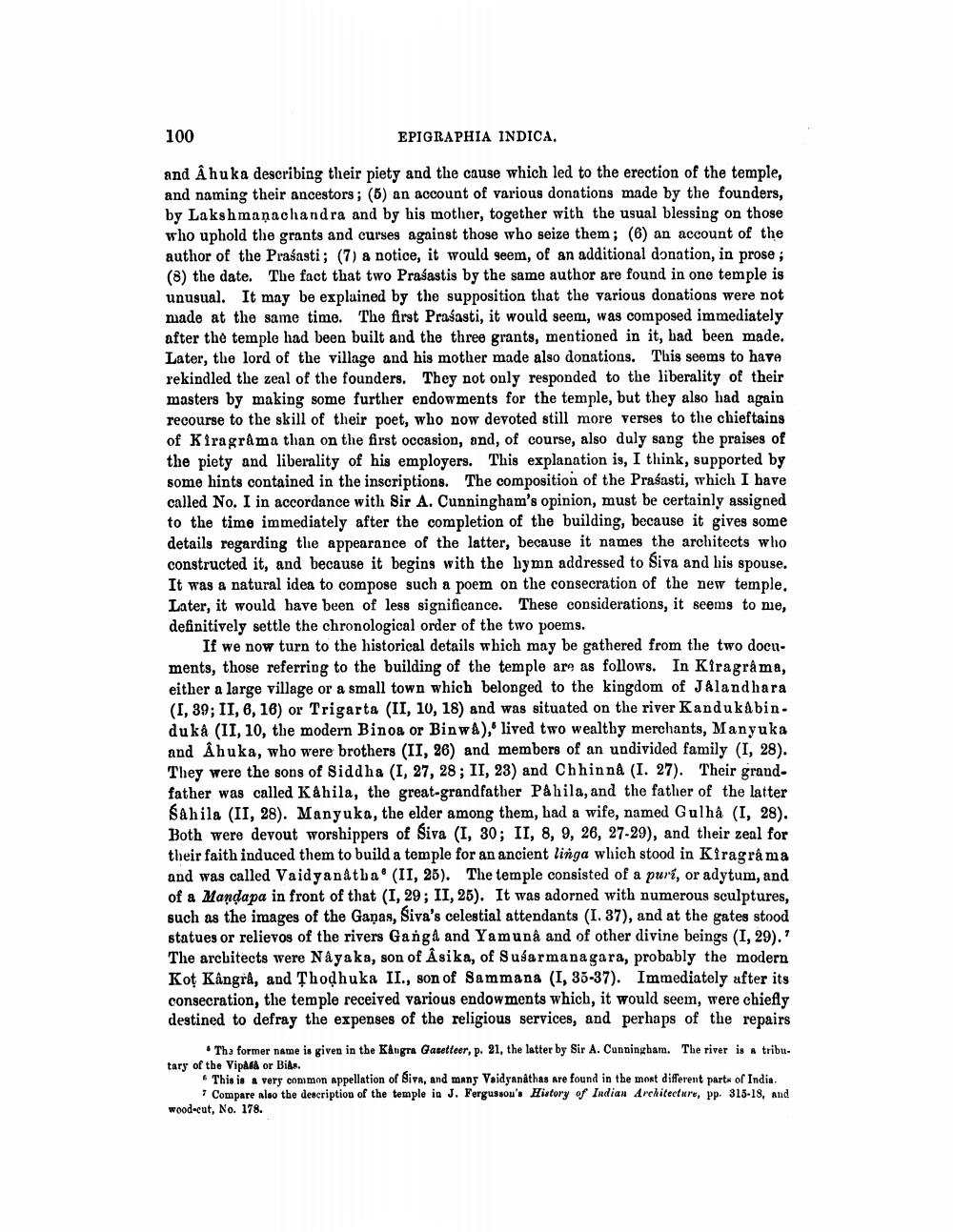________________
100
EPIGRAPHIA INDICA.
and Åhuka describing their piety and the cause which led to the erection of the temple, and naming their ancestors; (5) an account of various donations made by the founders, by Lakshmanachandra and by his mother, together with the usual blessing on those who uphold the grants and curses against those who seize them; (6) an account of the author of the Prasasti ; (7) a notice, it would seem, of an additional donation, in prose; (8) the date. The fact that two Prasastis by the same author are found in one temple is unusual. It may be explained by the supposition that the various donations were not made at the same time. The first Prasasti, it would seem, was composed immediately after the temple had been built and the three grants, mentioned in it, bad been made. Later, the lord of the village and his mother made also donations. This seems to have rekindled the zeal of the founders. They not only responded to the liberality of their masters by making some further endowments for the temple, but they also had again recourse to the skill of their poet, who now devoted still more verses to the chieftains of Kiragrama than on the first occasion, and, of course, also duly sang the praises of the piety and liberality of his employers. This explanation is, I think, supported by some hints contained in the inscriptions. The composition of the Prasasti, which I have called No. I in accordance with Sir A. Cunningham's opinion, must be certainly assigned to the time immediately after the completion of the building, because it gives some details regarding the appearance of the latter, because it names the architects who constructed it, and because it begins with the hymn addressed to Siva and his spouse. It was a natural idea to compose such a poem on the consecration of the new temple, Later, it would have been of less significance. These considerations, it seems to me, definitively settle the chronological order of the two poems.
If we now turn to the historical details which may be gathered from the two documents, those referring to the building of the temple are as follows. In Kiragrama, either a large village or a small town which belonged to the kingdom of Jalandhara (I, 39; II, 6, 16) or Trigarta (II, 10, 18) and was situated on the river Kandukabin. dukå (11, 10, the modern Binoa or BinwA), lived two wealthy merchants, Manyuka and Åhuka, who were brothers (II, 26) and members of an undivided family (I. 28). They were the sons of Siddha (I, 27, 28; II, 23) and Chhinna (I. 27). Their grandfather was called Káhila, the great-grandfather Pahila, and the father of the latter Sahila (II, 28). Manyuka, the elder among them, had a wife, named Gulha (I, 28). Both were devout worshippers of Siva (I, 30; II, 8, 9, 26, 27-29), and their zeal for their faith induced them to build a temple for an ancient linga which stood in Kiragráma and was called Vaidyanatba® (II, 25). The temple consisted of a purt, or adytum, and of a Mandapa in front of that (I, 29; II, 25). It was adorned with numerous sculptures, such as the images of the Gapas, Siva's celestial attendants (I. 37), and at the gates stood statues or relievos of the rivers Ganga and Yamuna and of other divine beings (I, 29).' The architects were Nayaka, son of Asika, of Sušarmanagara, probably the modern Kot Kångra, and Thodhuka II., son of Sammana (1, 35-37). Immediately after its consecration, the temple received various endowments which, it would seem, were chiefly destined to defray the expenses of the religious services, and perhaps of the repairs
• Tha former name in given in the Kaugra Gazetteer, p. 21, the latter by Sir A. Cunningham. The river is a tributary of the Vipada or Bids.
. This is a very common appellation of Siva, and many Vaidyanathas are found in the most different parts of India
* Compare also the description of the temple in J. Fergussou's History of Indian Architecture, pp. 318-19, and wood-cut, No. 178.




